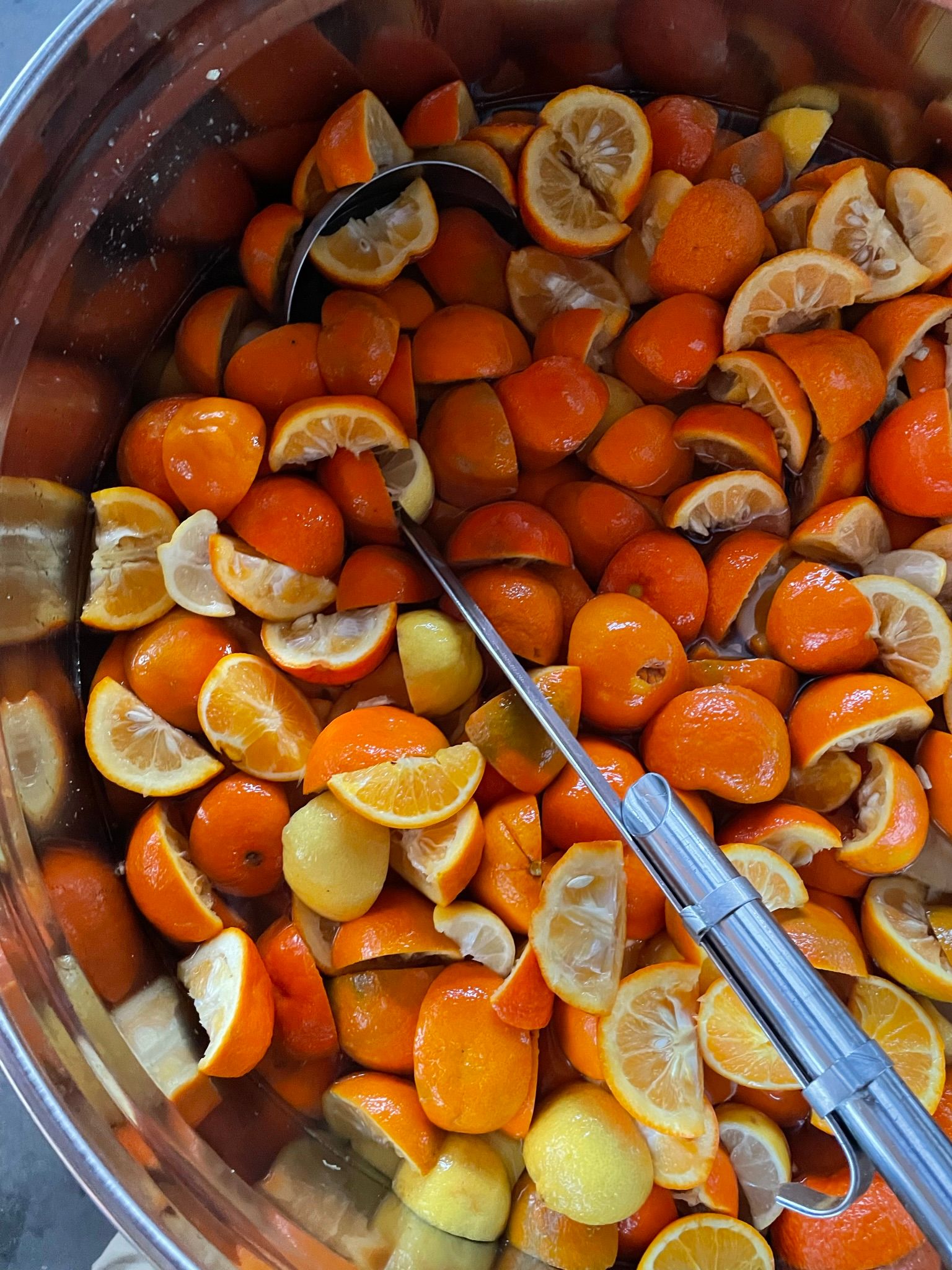Amaro

If you remember your first sip of coffee, beer, or cough medicine, you are likely recalling memories of your childhood palate’s introduction to bitterness. At first, you probably recoiled at the sensations this bitterness caused—maybe a prickle on the back of your tongue, a "yuk" face, and a flush of saliva flooding your mouth. Maybe you took to these bitter flavors right away, more likely you came around after years of experimentation. However it happened, odds are you’re a coffee or tea drinker now, you enjoy IPAs or Aperol spritzes, and you can appreciate the complexities of cardamom, citrus peels, and turmeric.
In discovering your love of life’s bitter pleasures, you overcame an evolutionary predisposition to avoid flavors which the human body has evolved to associate with poison. Bitterness in plants is common, and scientists have determined that bitter compounds are often present in plants that can kill or sicken you. The alkaloids, a famously psychoactive, biogenic, and toxic class of plant and animal-derived compounds (think: cocaine, caffeine, curare), are almost uniformly bitter to the taste. The body recognizes bitter and immediately sets to work on a cleanse of sorts, upping saliva production, increasing the flow of gastric juices, and kicking the colon into high gear to remove the bitter intruders from your body. But there are also some bitter compounds that benefit human health (aside from their purgative qualities), and humans have been extracting and consuming these compounds for centuries.
Drink Your Medicine, A History
Amaro, the time-honored Italian class of liqueurs, is known for making the most of these bitter compounds, in the name of both health and flavor. Part medicine, part tonic, part recreational draft, amaro is the culmination of centuries-old medical and alchemical experimentation. This isn't figurative marketing language, methods for extracting plant compounds in alcohol were canonical for researchers studying the elixir of life, the philosopher's stone, and chrysopoeia (making gold out of lead).
The 9th century Persian scholar Rhazes ("RAH-zees", latinized from Muhammad ibn Zakariyya al-Razi) contributed prolifically to alchemy, chemistry, and pharmacology, studying and documenting the curative properties of plants. According to the Great Big Book of Amaro by Matteo Zed, Rhazes was one of the first scholars to use distilled ethanol to extract the potent elements from plant matter. Two centuries later, the philosopher and physician Avicenna (Abu Ali al-Husayn ibn Abd Allah ibn Sina, sometimes described as the father of early modern medicine), documented 700 medicinal uses for botanicals in his collected treatise, The Canon of Medicine (Kitab al-Qanun fi al-tibb).
When the work of these scholars made its way across the Mediterranean to Italy, medieval monks, academics, and physicians (often the same person) studied and elaborated on the techniques. Scholar-physicians at the Medical School of Salerno improved on Arab distillation equipment, moving away from terracotta stills to more heat conductive copper alembics, allowing for better consistency and higher production capacity.
When Arnaldo da Villanova, the 13th century head of the Medical School of Salerno, successfully treated Pope Boniface VIII for kidney stones with what is now recognized as the first amaro, the drink became a byword for health and longevity. Monks and nuns began making their own amari across Italy, lay folk followed suit, and when New World imports depressed sugar prices in the 16th century, amari became more palatable—a draft consumed as much for pleasure as for health.
Whether enjoyed before a meal as an aperitivo, after a meal as a digestivo, or somewhere in between, bitter amari have cemented their place in the Italian consciousness as healthy, palate-cleansing drinks that make the most of nature’s bounty, and the rest of the drinking world has noticed.
Why do we taste bitterness in the first place?
Scientists still aren’t sure why humans perceive bitterness. They agree that we detect bitterness in foods that are toxic, but what about plants like wormwood, cacao beans, broccoli, hops, and grapefruit? All of them contain bitter-tasting phytochemicals (chemicals produced by plants) that have been shown to benefit the human body, from reducing inflammation to fighting microbes and bacteria.
According to Sarah McLagan, author of Bitter: A Taste of the World's Most Dangerous Flavor, the bitter naringin compound in grapefruit is used by researchers to treat ulcers, inhibit the growth of breast cancer cells, and induce cervical cancer cells to self-destruct. Quercetin, present in broccoli, green tea, and red wine, is used to treat lung cancer. When 19th century brewers began adding hops to their fermentations, they did so to better preserve their product without fully realizing that the same antibacterial compounds that prolonged shelf life were also aiding the drinker’s immune system. If so many of these bitter ingredients are good for us, why do we perceive them as bitter? And why do some of us find bitterness so unpleasant?
The excellent Gastropod podcast episode titled “The Bitter Truth” discusses a study on diet and genetics in African communities that seeks answers to the bitterness puzzle. As the evolutionary seat of humanity, the population of Africa is the most genetically diverse, making it ideal for a genetic study of differences in bitterness perception. But researchers like Sarah Tishkoff found that individuals within a community consuming a similar diet perceive bitterness differently from each other, and other communities with completely different diets are just as diverse. As Tishkoff explains it, the variation in bitter receptors from person to person is independent of region, community, or diet, and indicates that the perception of bitterness in humans on a large scale is more complex than just a warning signal to avoid toxic foods.
To further complicate the issue, scientists like Robert Margolskee have also discovered that the human body has bitter receptors all throughout the GI tract, and in other unlikely places such as the lungs, sinuses, and testes—yes, you read that right, testes (Fun fact: the testes also have receptors for sweet and umami. Any possible uses for these oddly-placed flavor receptors, evolutionarily or otherwise, is way beyond the scope of this article). Margolskee tells us that scientists aren’t sure what purpose these bitter receptors serve, although he has a working hypothesis that they might provide a link to fertility research and the possibility of developing a non-hormonal male contraception.
Like so many subtopics in flavor research, the evolutionary reason for bitterness is elusive and complex. While we can point to some compelling connections between things like toxicity and bitterness, we mostly consume amari for cultural, traditional, or simply gastronomic reasons. Claims about what bitterness might mean or do for us are often based on historical anecdote or, at best, sparse data in a hyper-complex chemical research space.
How is amaro made?
The principle method of amaro production is extraction by maceration. Roots, barks, flowers, seeds, spices, berries—you name it—are placed in an ethyl alcohol solution which has typically been distilled from either grapes or grains. The alcohol, an effective solvent, pulls active ingredients and bitter flavors from the botanicals, and the resulting liquid is combined with a little (or a lot) of sugar and bottled for consumption. Variation in amari comes primarily from the selection of botanicals—often a closely guarded recipe that varies widely from producer to producer and region to region—and also from maceration time, solvent concentration (proof), and the final sugar content (often very high in modern commercial recipies).
Matteo Zed also mentions some high tech, modern extraction methods involving things like ultrasound or a Naviglio Extractor, which removes the compounds from botanicals without the use of heat and much more quickly than more traditional methods. But the more traditional methods of extraction—maceration, percolation, infusion, digestion, decoction, and distillation—are still the ones favored most by amari producers today.
At Pekut and Carwick, we like maceration, as it requires very little specialized equipment and we think it results in a more stable product. Our Vin d’Orange and umeshu liqueur are made this way, and we started playing with a new maceration of green walnuts for our house-made nocino release (cool your jets, it wont be ready for a year or two).
How many amaro brands are there?
Matteo Zed documents just over 300 brands of Italian Amaro in his book, each made with their own proprietary blend of botanicals, and many other countries produce amari-like bitters such as Danish Gammel Dansk, Czech Becherovska, and German Kräuterbitter. Some of these spirits are what Zed refers to as “true amari,” containing less than 70 grams of sugar per liter, whereas spirits like Averna fall into the amari liqueur category due to their higher level of sugar content. The use of these bitter spirits—mostly the Italian iterations—in craft cocktails has resulted in an uptick in popularity stateside, and we even hold out some hope for an amaro redemption of the American national sweet tooth.
Amaro, straddling both medicinal and recreational consumption (at least anecdotally), is a fascinating and centuries-old relic of early modern chemistry, medicine, and commercial beverage production. Even if that sunset-colored Aperol spritz you’re drinking doesn’t cure what ails you, it is surely broadening the spectrum of flavors that your palate can enjoy, and variety is most certainly the spice that makes life interesting. Something to mull on over your next negroni.

